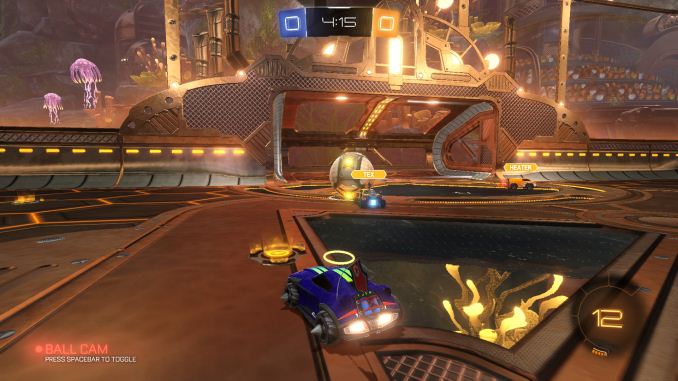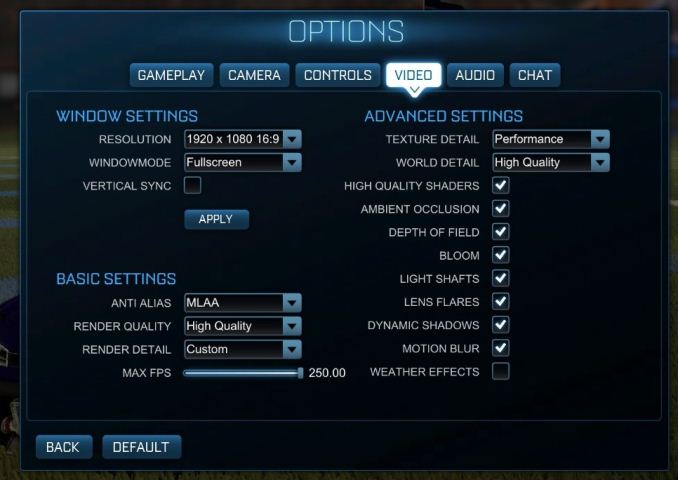Retesting AMD Ryzen Threadripper’s Game Mode: Halving Cores for More Performance
by Ian Cutress on August 17, 2017 12:01 PM ESTRocket League
Hilariously simple pick-up-and-play games are great fun. I'm a massive fan of the Katamari franchise for that reason — passing start on a controller and rolling around, picking up things to get bigger, is extremely simple. Until we get a PC version of Katamari that I can benchmark, we'll focus on Rocket League.
Rocket League combines the elements of pick-up-and-play, allowing users to jump into a game with other people (or bots) to play football with cars with zero rules. The title is built on Unreal Engine 3, which is somewhat old at this point, but it allows users to run the game on super-low-end systems while still taxing the big ones. Since the release in 2015, it has sold over 5 million copies and seems to be a fixture at LANs and game shows. Users who train get very serious, playing in teams and leagues with very few settings to configure, and everyone is on the same level. Rocket League is quickly becoming one of the favored titles for e-sports tournaments, especially when e-sports contests can be viewed directly from the game interface.
Based on these factors, plus the fact that it is an extremely fun title to load and play, we set out to find the best way to benchmark it. Unfortunately for the most part automatic benchmark modes for games are few and far between. Partly because of this, but also on the basis that it is built on the Unreal 3 engine, Rocket League does not have a benchmark mode. In this case, we have to develop a consistent run and record the frame rate.
Read our initial analysis on our Rocket League benchmark on low-end graphics here.
With Rocket League, there is no benchmark mode, so we have to perform a series of automated actions, similar to a racing game having a fixed number of laps. We take the following approach: Using Fraps to record the time taken to show each frame (and the overall frame rates), we use an automation tool to set up a consistent 4v4 bot match on easy, with the system applying a series of inputs throughout the run, such as switching camera angles and driving around.
It turns out that this method is nicely indicative of a real bot match, driving up walls, boosting and even putting in the odd assist, save and/or goal, as weird as that sounds for an automated set of commands. To maintain consistency, the commands we apply are not random but time-fixed, and we also keep the map the same (Aquadome, known to be a tough map for GPUs due to water/transparency) and the car customization constant. We start recording just after a match starts, and record for 4 minutes of game time (think 5 laps of a DIRT: Rally benchmark), with average frame rates, 99th percentile and frame times all provided.
The graphics settings for Rocket League come in four broad, generic settings: Low, Medium, High and High FXAA. There are advanced settings in place for shadows and details; however, for these tests, we keep to the generic settings. For both 1920x1080 and 4K resolutions, we test at the High preset with an unlimited frame cap.
All of our benchmark results can also be found in our benchmark engine, Bench.
MSI GTX 1080 Gaming 8G Performance

1080p



4K



Sapphire Nitro R9 Fury 4G Performance

1080p



4K



Sapphire Nitro RX 480 8G Performance

1080p



4K



With Ryzen, we encounted some odd performance issues when using NVIDIA-based video cards that caused those cards to significantly underperform. However equally strangely, the issues we have with Ryzen on Rocket League with NVIDIA GPUs seem to almost vanish when using Threadripper. Again, still no easy wins here as Intel seems to take Rocket League in its stride, but Game mode still helps the 1950X. The Time Under graphs give some cause for concern, with the 1950X consistently being at the bottom of that graph.












104 Comments
View All Comments
peevee - Friday, August 18, 2017 - link
Of course. Work CPUs must be tested at work. Kiddies are fine with i3s.Ian Cutress - Sunday, August 20, 2017 - link
https://myhacker.net hacking news hacking tutorials hacking ebooksIGTrading - Thursday, August 17, 2017 - link
It would be nice and very useful to post some power consumption results at the platform level, if we're doing "extra" additional testing.It is very important since we're paying for the motherboard just as much as we pay for a Ryzen 5 or even Ryzen 7 processor.
And it will correctly compare the TCO of the X399 platform with the TCO of X299.
jordanclock - Thursday, August 17, 2017 - link
So it looks like AMD should have gone with just disabling SMT for Game Mode. There are way more benefits and it is easier to understand the implications. I haven't seen similar comparisons for Intel in a while, perhaps that can be exploration for Skylake-X as well?HStewart - Thursday, August 17, 2017 - link
I would think disable SMT would be better, but the reason maybe in designed of link between the two 8 Core dies on chip.GruenSein - Thursday, August 17, 2017 - link
I'd really love to see a frame time probability distribution (Frame time on x-axis, rate of occurrence on y-axis). Especially in cases with very unlikely frames below a 60Hz rate, the difference between TR and TR-GM/1800X seem most apparent. Without the distribution, we will never know if we are seeing the same distribution but slightly shifted towards lower frame rates as the slopes of the distribution might be steep. However, those frames with frame times above a 60Hz rate might be real stutters down to a 30Hz rate but they might just as well be frames at a 59,7Hz rate. I realize why this threshold was selected but every threshold is quite arbitrary.MrSpadge - Thursday, August 17, 2017 - link
Does AMD comment on the update? What's their reason for choosing 8C/16T over 16C/16T?> One could postulate that Windows could do something similar with the equivalent of hyperthreads.
They're actually already doing that. Loading 50% of all threads on an SMT machine will result in ~50% average load on every logical core, i.e. all physical cores are only working on 1 thread at a time.
I know mathematically other schedulings are possible, leading to the same result - but by now I think it's common knowledge that the default Win scheduler works like that. Hence most lightly threaded software is indifferent to SMT. Except games.
NetMage - Sunday, August 20, 2017 - link
Then why did SMT mode show differences from Creator mode in the original review?Dribble - Thursday, August 17, 2017 - link
No one is ever going to run game mode - why buy a really expensive chip and then disable half of it, especially as you have to reboot to do it? It's only use is to make threadripper look slightly better in reviews. Imo it would be more honest as a reviewer to just run it in creator mode all the time.jordanclock - Thursday, August 17, 2017 - link
The point is compatibility, as mentioned in the article multiple times. AMD is offering this as an option for applications (mainly games) that do not run correctly, if at all, on >16 core CPUs.